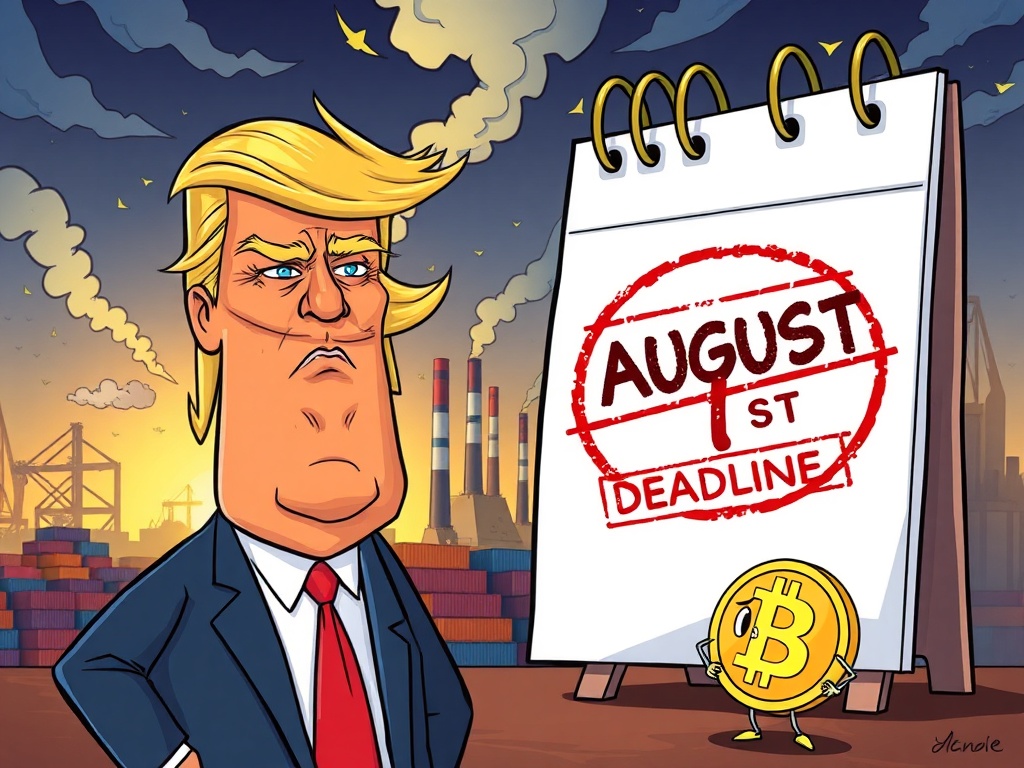BitcoinWorld

Bitcoin Short-Term Holders: Unveiling a Crucial Local Bottom Signal
In the often unpredictable world of cryptocurrency, market signals are highly sought after. Every dip, every surge, prompts a flurry of analysis as investors try to decipher the next move. Recently, a fascinating insight has emerged from CryptoQuant, suggesting that the behavior of Bitcoin short-term holders might be providing a crucial clue about an impending local bottom for BTC. Could this be the signal many have been waiting for? Let’s dive deep into what this means for the market and your investment strategy.
Understanding Bitcoin Short-Term Holders (STHs): Who Are They?
Before we dissect the signal, it’s important to understand who we’re talking about. In the crypto space, investors are often categorized by how long they hold their assets:
- Long-Term Holders (LTHs): These are individuals or entities who typically hold their Bitcoin for more than 155 days. They are often seen as conviction investors, less likely to be swayed by short-term price fluctuations. Their movements usually indicate broader market sentiment or macro trends.
- Short-Term Holders (STHs): Conversely, Bitcoin short-term holders are those who have held their BTC for less than 155 days. These investors are generally more reactive to immediate price movements. They might be traders looking for quick gains, or newer entrants to the market who are less experienced with volatility. Their buying and selling patterns can offer significant insights into immediate market sentiment and potential turning points.
The behavior of STHs is particularly interesting because their decisions are often driven by profit-taking or fear of loss in the near term. When a significant portion of these holders starts moving their coins, it can indicate a shift in short-term market dynamics.
The CryptoQuant Insight: What Does the Binance Inflow Ratio Tell Us?
The recent analysis by CryptoQuant contributor Amr Taha brought attention to a specific metric: the Binance inflow ratio of Bitcoin short-term holders. This metric measures the proportion of Bitcoin being deposited onto the Binance exchange by STHs relative to the total inflows. Here’s why this matters:
- Binance Inflow Ratio: This ratio tracks how much BTC is being sent to Binance, a major exchange, specifically from wallets identified as belonging to STHs. An increase in this ratio suggests that a higher percentage of incoming Bitcoin on Binance originates from these short-term investors.
- The 0.4 Threshold: Amr Taha highlighted that this ratio recently exceeded 0.4. Historically, this particular level has been associated with local bottoms for BTC. This means that in previous instances where STHs were depositing a significant amount of Bitcoin to Binance (above 40% of total inflows), the market often found a temporary floor shortly thereafter.
- Why Deposits? STHs typically deposit Bitcoin to exchanges for one primary reason: to sell. Whether they are taking profits after a price pump or cutting losses during a dip, the act of moving funds to an exchange usually precedes a transaction.
The core idea here is that if a large number of Bitcoin short-term holders are sending their coins to exchanges, likely to realize profits, it indicates that a significant amount of supply is hitting the market. If the market can absorb this selling pressure without a drastic price collapse, it suggests underlying demand is strong enough to establish a bottom.
Why Would STHs Taking Profits Signal a Local Bottom?
This might seem counterintuitive at first glance. If people are selling, shouldn’t the price go down? While selling pressure naturally pushes prices lower, the context of STH profit-taking at a specific ratio offers a nuanced perspective:
- Supply Exhaustion: When a significant number of STHs decide to take profits, it can signal that the short-term profit potential has been largely realized by this group. Once these immediate sellers have exited, the selling pressure from this cohort might temporarily exhaust itself.
- Absorption by Strong Hands: If the market manages to hold its ground or even bounce after a wave of STH profit-taking, it implies that stronger hands (often long-term holders or new institutional capital) are stepping in to buy up the available supply. This absorption creates a demand floor.
- Psychological Reset: A period of STH profit-taking can act as a psychological reset for the market. It clears out some of the speculative froth and allows for a more stable base to form before the next upward movement. It’s like a cleansing event that removes weaker hands.
Therefore, the increase in Binance inflows from Bitcoin short-term holders, particularly above the 0.4 threshold, isn’t just about selling; it’s about the market’s ability to absorb that selling and potentially turn it into a foundation for recovery.
Historical Precedent: Have Bitcoin Short-Term Holders Predicted Bottoms Before?
The power of this signal lies in its historical reliability. While no indicator is foolproof, past performance offers valuable context. According to Amr Taha’s analysis, the 0.4 Binance inflow ratio from STHs has consistently marked local bottoms. This suggests a recurring pattern in market behavior:
- Early 2023 Recovery: While specific data points are proprietary to CryptoQuant, market observers often point to periods following significant corrections where a flush-out of short-term speculative positions precedes a recovery. For instance, after the FTX collapse or during previous bear market troughs, a capitulation phase by short-term holders often paved the way for a rebound.
- Mid-Cycle Corrections: Even within a bull market, Bitcoin experiences corrections. These mid-cycle dips often see STHs taking profits or cutting losses, and if the market finds support after this, it can signal the end of that particular correction and the resumption of the broader trend.
The consistent correlation between this metric and local bottoms lends credibility to the current signal. It implies that the current wave of profit-taking by Bitcoin short-term holders could indeed be setting the stage for a near-term price reversal.
Navigating the Market: Actionable Insights for Investors
So, what does this insight mean for you as an investor or trader? While no single indicator guarantees future price movements, this signal from Bitcoin short-term holders offers valuable guidance:
- Potential Entry Point: For those looking to accumulate BTC or open new long positions, a confirmed local bottom presents an opportune entry point. This signal suggests that the selling pressure from STHs might be nearing its end, potentially reducing downside risk in the immediate future.
- Dollar-Cost Averaging (DCA): If you employ a DCA strategy, this could be a signal to consider increasing your regular purchases, as the market might be consolidating before an upward move.
- Risk Management is Key: Always remember that crypto markets are volatile. While the signal is promising, it’s crucial to manage your risk. Do not over-leverage or invest more than you can afford to lose.
- Combine with Other Indicators: This STH metric should not be your sole decision-making tool. Combine it with other technical analysis (e.g., RSI, MACD, support/resistance levels) and fundamental analysis (e.g., macroeconomic conditions, regulatory news, network developments) for a more comprehensive view.
- Monitor Follow-Through: Observe if the market indeed bounces and sustains its upward momentum after this signal. A strong follow-through would further validate the local bottom.
The insights derived from Bitcoin short-term holders are particularly useful for those with a shorter to medium-term investment horizon, looking to capitalize on market cycles.
Challenges and Considerations: Is the Signal Always Accurate?
While the CryptoQuant insight is compelling, it’s important to approach it with a balanced perspective. No market indicator is 100% accurate, and several factors can influence the outcome:
- Market Complexity: The crypto market is influenced by a myriad of factors, including global macroeconomic conditions, regulatory developments, technological advancements, and unpredictable ‘black swan’ events. A signal based on STH behavior might be overridden by larger forces.
- Lagging vs. Leading Indicator: While the metric identifies a potential bottom, it often confirms a trend that is already in motion. It’s not a crystal ball for predicting the exact low point.
- Changing Market Dynamics: The crypto market evolves rapidly. What was historically reliable might become less so as market participants, technologies, and regulations change.
- Whale Activity: Large institutional or individual holders (whales) can move markets significantly, sometimes overriding the signals from smaller STHs.
Therefore, while the behavior of Bitcoin short-term holders offers a powerful lens into market sentiment, it should be used as part of a broader analytical framework rather than a standalone prophecy.
Conclusion: A Promising Glimmer for Bitcoin’s Short-Term Future
The analysis from CryptoQuant contributor Amr Taha, highlighting the Binance inflow ratio from Bitcoin short-term holders exceeding 0.4, offers a promising glimmer of hope for a potential local bottom in BTC. Historically, this behavior has coincided with periods where the market found its footing after a dip, suggesting that the current wave of profit-taking by STHs might be clearing the path for a near-term recovery. While no indicator is foolproof, this insight provides a valuable perspective for investors navigating the volatile crypto landscape. By understanding the motivations and movements of Bitcoin short-term holders, you can gain a deeper appreciation for market dynamics and potentially make more informed decisions. Always remember to conduct your own research, consider multiple data points, and manage your risk effectively. The journey in crypto is always an adventure, and signals like these help illuminate the path forward.
Frequently Asked Questions (FAQs)
Q1: What is a “local bottom” in cryptocurrency?
A local bottom refers to a temporary low point in an asset’s price within a larger trend. It’s not necessarily the absolute lowest price it will ever reach, but rather a point where selling pressure subsides, and the price finds short-term support before potentially resuming an upward or sideways trend.
Q2: How are Bitcoin short-term holders (STHs) different from long-term holders (LTHs)?
Bitcoin short-term holders are addresses that have held their BTC for less than 155 days, typically being more reactive to immediate price changes and seeking quick profits. Long-term holders (LTHs) have held their BTC for more than 155 days, often indicating stronger conviction and less susceptibility to short-term market fluctuations.
Q3: What is the Binance inflow ratio for Bitcoin short-term holders?
This metric measures the proportion of Bitcoin being deposited onto the Binance exchange specifically from wallets identified as belonging to short-term holders. A high ratio indicates that a significant amount of BTC entering Binance for potential sale is coming from these short-term investors.
Q4: Why does STH profit-taking potentially signal a local bottom?
When Bitcoin short-term holders take profits, it signifies a wave of selling pressure. If the market can absorb this supply without further significant price drops, it suggests that demand is strong enough to establish a price floor. This can indicate that the immediate selling pressure from this cohort is exhausted, paving the way for a potential rebound.
Q5: Is this signal from Bitcoin short-term holders a guaranteed indicator?
No, no single indicator in the crypto market is guaranteed. While the historical correlation of the 0.4 Binance inflow ratio from STHs with local bottoms is compelling, it should be used in conjunction with other technical and fundamental analysis. The market is complex and influenced by many unpredictable factors.
Did you find this analysis helpful? Share this article with your fellow crypto enthusiasts and help them stay informed about crucial market signals!
To learn more about the latest Bitcoin market trends, explore our article on key developments shaping Bitcoin price action.
This post Bitcoin Short-Term Holders: Unveiling a Crucial Local Bottom Signal first appeared on BitcoinWorld and is written by Editorial Team





